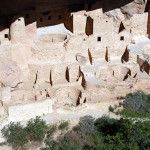As we were driving away from the Santuario de Chimayo on this Holy Saturday past, we noticed another shrine nearby. Upon further inspection, we discovered it was the Santo Nino Chapel, also located right in Chimayo, NM.
The story of Santo Nino begins in Spain during the time of the Moors, Muslim conquerors of Spain. In Atocha, just outside Madrid, many Christian men had been imprisoned and only children were permitted to visit the prisoners and bring them food.The women of the village prayed to Our Lady for help and soon word spread that a young child was visiting the prisoners. Surprisingly, his basket was never empty of food and the gourd he carried, always filled with water. He was considered a manifestation of Jesus Christ as the Holy Child, thus, the “Santo Nino”.
 In 1492, the Catholics drove the Muslims out of Spain and Spanish colonists subsequently brought the worship of Our Lady of Atocha and her Holy Child to Mexico. As in Spain, they were often portrayed as the Virgin with the Holy Child in her arms. The child was often removed and taken to be present at difficult births. Over time, Santo Nino’s reputation for miracles grew. It was said he traveled the countryside at night spreading miracles, especially among the imprisoned, the poor and the ill.
In 1492, the Catholics drove the Muslims out of Spain and Spanish colonists subsequently brought the worship of Our Lady of Atocha and her Holy Child to Mexico. As in Spain, they were often portrayed as the Virgin with the Holy Child in her arms. The child was often removed and taken to be present at difficult births. Over time, Santo Nino’s reputation for miracles grew. It was said he traveled the countryside at night spreading miracles, especially among the imprisoned, the poor and the ill.
 Santo Nino is currently one of the most popular saints in New Mexico. In 1857, Severiano Medina, a resident of Chimayo, made a pilgrimage to the shrine in Mexico and brought a statue back to his home. He built the chapel that we saw near the Santuario in 1857 upon his return to honor the Santo Nino and popularity of the Holy Child continued to spread. The chapel is built in the traditional northern New Mexico style using adobe wall spanned by great wooden vigas and rough stone floors.
Santo Nino is currently one of the most popular saints in New Mexico. In 1857, Severiano Medina, a resident of Chimayo, made a pilgrimage to the shrine in Mexico and brought a statue back to his home. He built the chapel that we saw near the Santuario in 1857 upon his return to honor the Santo Nino and popularity of the Holy Child continued to spread. The chapel is built in the traditional northern New Mexico style using adobe wall spanned by great wooden vigas and rough stone floors.
During World War II, many New Mexican citizens in the armed forces suffered through the seige of Corregidor, the Bataan Death March, and internment in Japanese prison camps. They prayed to the Santo Niño, and upon their return, some 2,000 made a pilgrimage to the Santuario—some walking barefoot—to give thanks for their lives.
 Believers and visitors to the Santo Nino shrine bring and leave him baby shoes to replace the ones he supposedly wears out in his travels. A Santo Nino Museum also opened in 2010 and replicates the childhood of Jesus.
Believers and visitors to the Santo Nino shrine bring and leave him baby shoes to replace the ones he supposedly wears out in his travels. A Santo Nino Museum also opened in 2010 and replicates the childhood of Jesus.
The wonderful restaurant nearby both shrines is ironically named Medina’s. I wonder if there is a connection to Severiano? For more information about visiting New Mexico, read more about New Mexico campgrounds and things to do in New Mexico.

